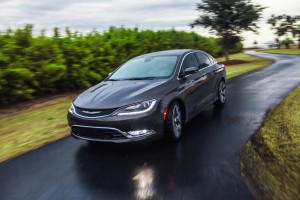
The 2015 Chrysler 200 will be the first vehicle to get stop-start technology with the Jeep Cherokee coming along later this year.
Chrysler will offer the new stop-start technology on two of its newest models for 2015, with more products likely to get the fuel-saving system over the next few years.
Stop-start will become standard on the 2.4-liter version of the all-new 2015 Chrysler 200 sedan, as well as on the Jeep Cherokee equipped with the maker’s 3.2-liter Pentastar V-6.
The technology briefly shuts the engine off when the vehicle comes to a halt at a stoplight or on, say, a fast food line, automatically firing back up when the driver’s foot lifts off the brake. Estimates of the benefits vary, though Chrysler predicts stop-start should improve fuel economy by about 3% on the Chrysler 200 and Jeep Cherokee, while reducing emissions by about 3%, as well.
“We’re taking highly efficient engines and upping the ante to further benefit our customers,” said Mike Duhaime, Global Director-Electrified Powertrain Propulsion Systems. “ESS leverages intricate control strategies to deliver a superior driving experience, as well as the expected fuel-savings and emissions-reduction.”
Stop-start, sometimes referred to as micro-hybrid technology, has become increasingly common across the automotive industry, and some forecasters anticipate it will become the norm, rather than the exception, as the industry approaches 2025, when the U.S. Corporate Average Fuel Economy jumps to 2025. Tougher fuel economy and emissions standards in Europe, Japan, China and other markets have already made the technology commonplace.
Even luxury manufacturers like Porsche, BMW and Mercedes-Benz have adopted stop-start – in part because they face more of a challenge bringing their big, gas-guzzling engines into compliance with future fuel economy rules. But as costs dip, the technology is moving rapidly into mainstream.
It will become standard on the Chevrolet Impala and available on the Chevy Malibu in 2015. Ford now has it on the midsize Fusion and the maker says it will be available on 70% of its product line-up by 2017. About 50% of the vehicles sold in Europe now feature stop-start.
(Toyota, GM, Ford top vehicle safety watch list. For more, Click Here.)
While stop-start is a new addition to the Chrysler passenger car and crossover/utility vehicle line-up, the maker is already using the technology to boost the fuel economy of its big Ram 1500 HFE pickup. Equipped with the 3.6-liter Pentastar V-6, the truck yields an EPA estimated 18 mpg City, 25 Highway, a 1 mpg increase over the same package without stop-start.
(Click Here for details about how U.S. automakers will set a new record for recalls.)
The Chrysler system relies on a beefed-up starter that’s designed to bring crank – or re-start – times down to about 0.3 seconds, less than it would take for a motorist’s foot to move from the brake to the gas pedal.
(To see the new Ford Focus ST’s debut at the Goodwood Festival of Speed, Click Here.)
Various manufacturers have used different approaches to stop-start – and have generated different responses from the public. BMW is one of several makers that have been faulted by reviewers and owners alike for both the roughness and unpleasant sound of its system. Other manufacturers have been praised for stop-start systems that are so seamless a driver might not know when the engine has been shut off, or one it starts up again.
Like most stop-start systems, Chrysler will allow a driver to disable the technology.
